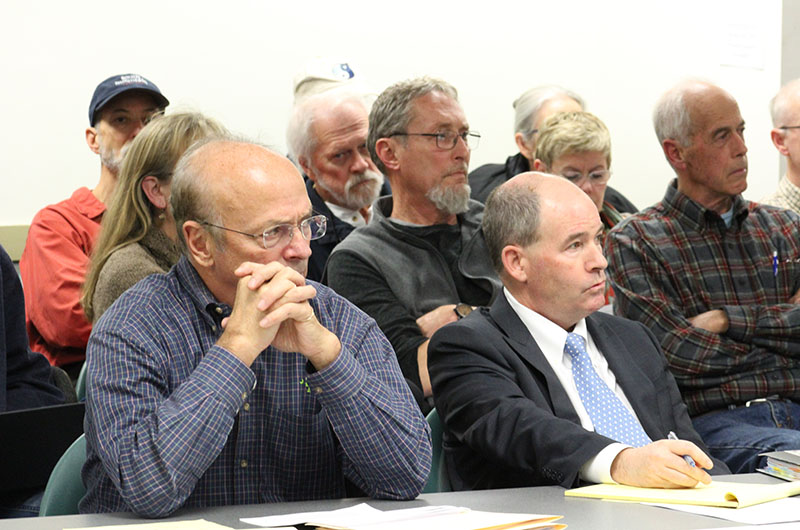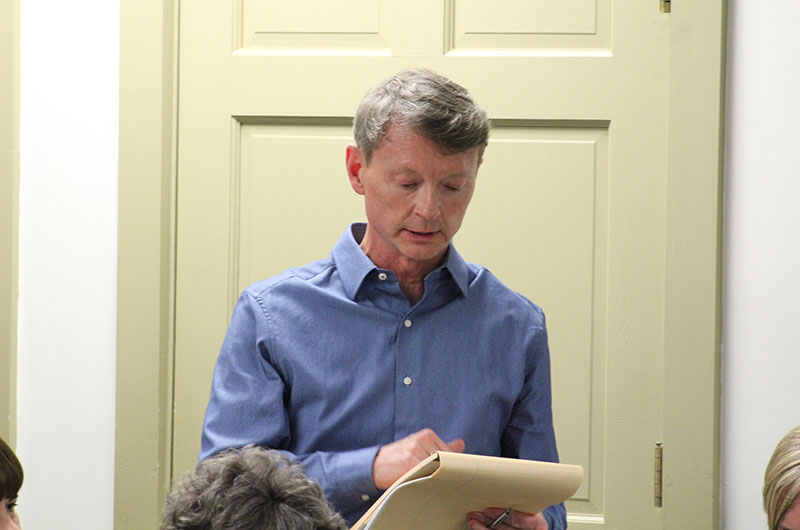Neighbors, Island environmental leaders and others turned out in force last week to raise strong objections to a large subdivision planned for Meeting House Way in Edgartown.
“Who stands to benefit outside of a small number of people? The environment and community lose out on this,” said Jeffrey Agnoli, a neighbor in the wooded rural area where the subdivision is planned.
The comment came during a hearing before the Martha’s Vineyard Commission last Thursday night. The plan for 34 market-rate homes on 54 acres situated between Meetinghouse and Meshacket is under review as a development of regional impact (DRI).
The applicants are a pair of developers based in Salt Lake City, Utah. Both principals in a limited liability company, Douglas K. Anderson and Richard G. Matthews bought the undeveloped land in June 2017 for $6.6 million. Mr. Anderson attended the hearing along with his representatives, Island attorney Sean Murphy and civil engineer Doug Hoehn.
The plan for Meetinghouse Place calls for creating three clusters of buildable lots. Homes would be limited to 5,000 square feet with no freestanding guest houses although bedrooms would be allowed over garages. The development would have two entrances, one off Meshacket and one off Meetinghouse Way. The development would use town water and town sewer. Three ancient ways cross the property. Between 16 and 17 acres is listed as habitat for the rare imperial moth under the state Natural Heritage and Endangered Species Program. Developers have offered to preserve some rare habitat on the site and contribute funding for offsite research. They are also proposing a sizable contribution to affordable housing: $1.11 million paid out in three installments to the Edgartown affordable housing committee plus one per cent of the sale price on individual lots that would go to the Dukes County Regional Housing Authority.
“It’s probably the most significant affordable housing donation that we’ve ever been involved in,” said Mr. Anderson who made brief remarks at the hearing.
A commission staff analysis has identified habitat loss and a strain on overburdened town water and wastewater infrastructure as key issues.
Commission water quality planner Sheri Casseau said even though the project plans to connect to the town wastewater facility, it would add significant amounts of nitrogen to the overloaded watershed for the Edgartown Great Pond. She estimated that the property would produce 138 kilograms of nitrogen per liter per year, well above the 76-kilogram limit set by the MVC.
Pio Lombardo, an environmental consultant hired by the developer, countered that analysis, saying that nitrogen could fall to nearly 50 per cent below the limit if developers build an onsite well and permeable reactive barrier.
Commissioners will hire an independent consultant to review both evaluations, at the expense of the developer. “Your numbers and his numbers are about as far away as they can be,” commission chairman Douglas Sederholm observed following the presentation by Ms. Casseau and Mr. Lombardo.
Public comment centered mostly on environmental impacts.
“I’m here to speak for the water,” said Emily Reddington, executive director of the Edgartown Great Pond Foundation. “We’ve made incredible progress as a community reducing nitrogen. If you add any nitrogen . . . it can throw off the progress we’ve already made.”
Luanne Johnson, a wildlife biologist and executive director for BioDiversity Works, said in addition to the imperial moth, with its pitch pine forest the property also likely harbors colonies of rare Northern long-eared bats.
“If turning this Island into the mainland isn’t enough to make you deny this proposal . . . I ask you to think of the wildlife that have lost a tremendous amount on this Island,” Ms. Johnson told the commission.
Chandler Lincoln, a neighbor, said the development could be a tipping point.
“Extinction occurs one species at time,” he said.
James Athearn, whose family owns Morning Glory Farm off Meshacket Road and who formerly served on the commission, urged members to reject the plan.
“It’s the job of this commission to preserve and protect [Martha’s Vineyard],” Mr. Athearn said. “So do your job and we’ll all be as proud of you as we are of the Patriots.”
The hearing was continued to March 7.









Comments (22)
Comments
Comment policy »